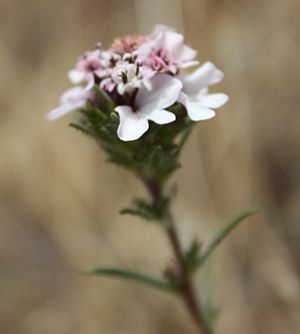Calycadenia facts for kids
Quick facts for kids Western rosinweeds |
|
|---|---|
 |
|
| Calycadenia multiglandulosa | |
| Scientific classification | |
| Kingdom: | |
| (unranked): | |
| (unranked): | |
| (unranked): | |
| Order: | |
| Family: | |
| Tribe: |
Madieae
|
| Genus: |
Calycadenia
|
Calycadenia is a group of flowering plants. They are also known as western rosinweeds. These plants belong to the aster family, called Asteraceae. You can find them mostly in California, especially around the Central Valley. Two types, (C. fremontii + C. truncata), also grow a bit further north in Oregon.
Contents
What Do Western Rosinweeds Look Like?
These plants are annual herbs. This means they grow from a seed, flower, produce seeds, and then die, all within one year. They can be very small, just a few centimeters tall, or grow to be over one meter (about 3 feet) tall.
Smell and Leaves
Many Calycadenia plants have a nice smell. Their leaves are usually arranged in an alternate pattern along the stem. This means each leaf grows on a different side, one after the other. However, one type, C. oppositifolia, has opposite leaves. This means two leaves grow directly across from each other on the stem.
The leaves are long and thin, a bit like grass blades. Sometimes, their edges have small teeth.
Flower Heads and Glands
The flowers of Calycadenia grow in groups called flower heads. These heads can be single or grow in open groups or clusters where the leaves meet the stem.
The small stems that hold the flower heads are called peduncles. These peduncles have special leaf-like parts called bracts. These bracts often have unique, tack-shaped glands on them. Glands are tiny structures that can produce sticky or oily substances.
Each flower head usually has one or more phyllaries. These are like small leaves that are attached to the ray florets. Ray florets are the petal-like flowers around the edge of the head. These phyllaries often have the same tack-shaped glands.
Flower Colors and Parts
Each flower head has a few ray florets, usually one to six. These are the showy, petal-like parts. They can be white, cream, pink, or yellow. Some even have a dark red spot near their base.
In the center of the flower head are up to 25 disc florets. These are smaller, tube-shaped flowers. They can be white, cream, pink, or yellow. The parts inside the disc florets that hold pollen, called anthers, are usually purple or black, but sometimes yellow or brown.
Seeds and Name Origin
After the flowers bloom, they produce a type of fruit called a cypsela. These are small, angular seeds. The seeds from the disc flowers often have a pappus. This is a crown of scales that helps the seeds float away in the wind.
The tack-shaped glands on the peduncles and phyllaries are a special feature of Calycadenia. The name Calycadenia comes from two Greek words: calyx, meaning "cup," and aden, meaning "gland." This name refers to these unique glands.
How Western Rosinweeds Grow
Most Calycadenia species cannot pollinate themselves. This means they need pollen from another plant of the same type to make seeds.
These plants can be quite varied. Some species have different "races" or types that look very similar but have different numbers of chromosomes (the parts of cells that carry genetic information). Other species have races that look different but all have the same chromosome count.
Types of Western Rosinweeds
Here are some of the different types of Calycadenia:
- Calycadenia fremontii – This is called Frémont's western rosinweed.
- Calycadenia hooveri – Known as Hoover's western rosinweed.
- Calycadenia micrantha – This one has small flowers.
- Calycadenia mollis – Called soft western rosinweed.
- Calycadenia multiglandulosa – This is the sticky western rosinweed.
- Calycadenia oppositifolia – Known as Butte County western rosinweed.
- Calycadenia pauciflora – This is the smallflower western rosinweed.
- Calycadenia spicata – Called spiked western rosinweed.
- Calycadenia truncata – This is the Oregon western rosinweed.
- Calycadenia villosa – Known as dwarf western rosinweed.
Plants Formerly in This Group
Sometimes, scientists move plants from one group to another as they learn more.
- Calycadenia tenella Torr. & A. Gray, is now called Osmadenia tenella Nutt.
See also
 In Spanish: Calycadenia para niños
In Spanish: Calycadenia para niños

